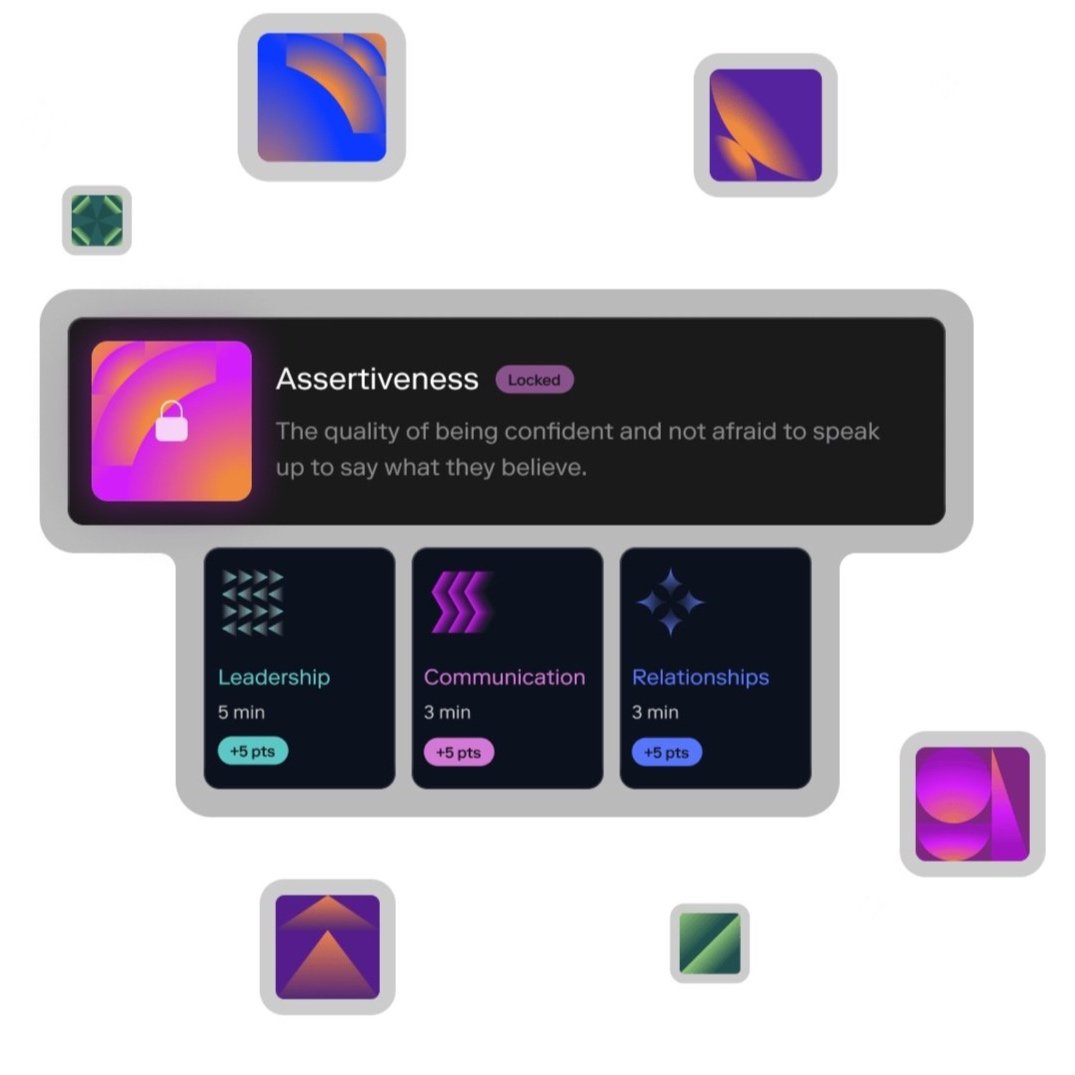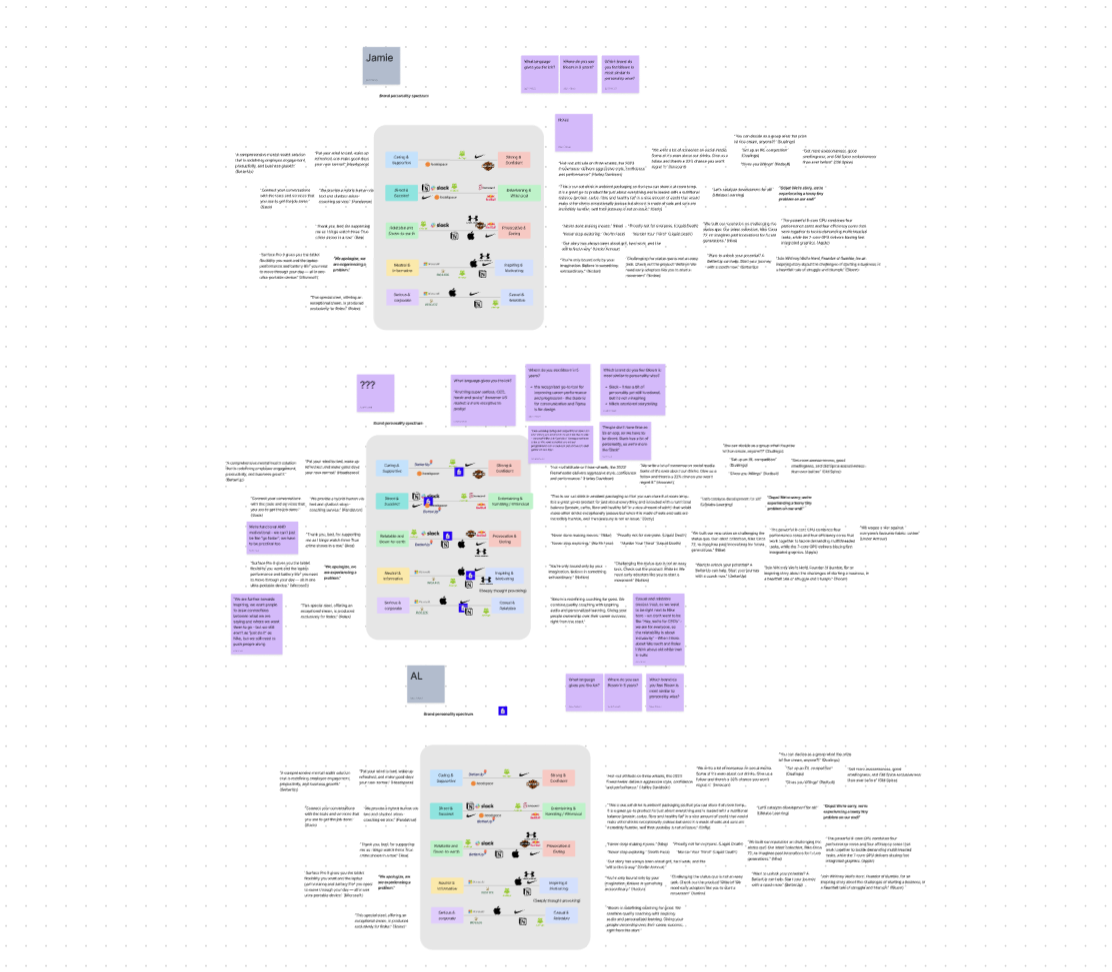
Energising careers
with Bloom
OVERVIEW
Bloom's mission is to scale career coaching to all employees. Bloom was entering an already crowded space and needed to distinguish itself amongst a sea of new AI-driven career coaching apps and industry leaders. It was also clear from user testing that there was an opportunity to improve and simplify the user experience and create greater clarity and consistency.
CLIENT
INDUSTRY
Technology, B2B
SCOPE
Lead UX Writer
Lead Brand Strategist
The Challenge
Project goals
Creating an experience that empowers users (employees) to reach greater heights at work.
Deliver a stand-out go-to-market positioning and messaging ahead of the September launch.
Disrupt the way traditional career coaching is delivered, experienced, and perceived (elitist, reliant on 1hr weekly sessions, long wait time in between sessions, time-consuming, non-dynamic, purely conversational)
Define Bloom’s purpose, mission, values, and brand positioning.
Align everyone in the team with a clear and consistent brand, narrative, and content throughout the product.
Research & Understanding
Alongside the product team, I worked to determine an approach, proceeding with a discovery phase through user testing and other research methods to understand the problems faced.
Desk research
Spent time scouring Google Trends and search tools to identify keywords and relevant search topics as well as going through previous research.
Surveys and user testing
Our team conducted user interviews to gather more data about the current onboarding flow, using a mix of moderated and unmoderated interview sessions. This gave me a good understanding of the current state of the brand language: learning about the way they talk to customers, and users and getting to know the product inside out. I also used the insights gained to help with the creation of user needs, user journeys and empathy maps.
Benchmarking
I looked at existing competitors in the career coaching and L&D space such as BetterUp, as well as lateral brands in the learning, education, games or wellness sectors, such as Duolingo, and Headspace. My goal was to identify parallels and opportunities as well as to gain an understanding of the way these brands speak about themselves and their users.
Kick-off interviews
I conducted a day of initial interviews with specific members of the Bloom team, including the CEO, Founder, Head of Growth, and Head of Coaching, discussing early assumptions, looking at potential opportunities and exploring directions and ideas for the brand, like how we speak about ourselves. This helped me learn about Bloom’s customers — what they care about and how we can best show up for them as a growth partner, whilst helping their teams succeed.


Brand personality workshop with the team
Positioning
A career is not a set of tasks you routinely fulfil for a paycheck; a career is much more personal. Career coaching isn’t just about 1:1 sessions; it’s the daily learning, reflection, growth, and inspiration that help you reach new heights.
User testing insights; language evolution
We quickly discovered key insights into users’ mental models for career coaching, which would influence the language changes we would need to make. Below is a list of the terminology and language that we evolved as a result of the user testing:
Language
Coaching app: users were unclear and anticipated coaching for mental health in the workplace.
Workouts: users are unclear about what a Workout involves as it was not previously explained. Terms related to fitness were also widely used. However, this wasn’t right for the professional coaching experience and created too much crossover with fitness coaches.
Growth goals: clearer, simpler naming categories are needed; reduce to just ‘goals’.
Industry leaders, Bloom Experts: these names were decided on for the industry leaders being interviewed for audio content. However, both downplayed the expertise of the leaders. I encouraged a change to either ‘Bloom Speakers’ or ‘Bloom Leaders’ to add more prestige to their title.
Mentoring – mentoring implies more skill-based training rather than coaching, and suggests a more hands-on approach.
Avoiding any wellness-related language was key to keeping the product focused on career aspirations and self-growth.
The lack of clear user benefits meant user understanding was limited by the time they got to the coach booking page – weave in three key value propositions.
The previous language like ‘commit to success’ was too aggressive and non-inclusive. My goal was to soften and inject warmth.
UX flow
Building a dashboard and enabling users to explore before booking a coaching session would make their experience feel more personalised.
In the onboarding process, users were highly motivated to sign up. However, they couldn’t explore the app until they had booked and had their first coaching call, which removed all the energy and momentum that goes through the process of getting a conversion. Depending on how long it took to receive their coaching call, the user might be in a completely different mindset a week later. However, this flow was detrimental to the user experience.
Users would prefer to be able to explore the app before booking their first coaching session. Many felt apprehensive and wanted to understand the product better before signing up.
Users thought they could book unlimited coaching sessions, when in fact sessions were incremental at six key points throughout the year.
Users lack trust in the coaches since the session happens via chat, without video. Would like to see the coaches’ faces or know who they are talking to.
Strategic process
-
Launch Bloom’s value proposition, positioning and brand strategy. Closely collaborate with key stakeholders, including the CEO, Founder, and Chief Growth officer to align on key messaging and language.
-
Launch our first brand and messaging guidelines. Foster a company-wide shift in how we talk about our brand, customers and product.
-
Align with product team on language, how we were positioning Bloom in the UI and on the App Store, and our overall brand voice and tone throughout the onboarding flow.
-
Reconfigue Bloom’s taxonomy and naming across key features. Embed closely with the product design and user research team for the onboarding flow.
-
Collaborate with Head of Coaching to oversee and help create a consistent framework for the writing of 200+ coaching exercises and 450 psychometrics.
-
Develop the content strategy framework and strategy to help grow our online presence and attract new leads, through content, social and comms.
-
Better manage user expectations in onboarding, clearly explain what the product is, does, and why it benefits them.
-

User personas
Using the personas we defined user motivations to help with improving the content across the UI screens in the overall Onboarding flow.
-

Information architecture
We gathered the most important content first and redesigned the flow to validate changes in the structure, also creating comms like the initial Welcome Email.
-

Testing the language
Since we had the ability to test user reactions and interactions, we had a lot of creative freedom to try new messaging and test the copy.
-

Exploring taxonomy
Defining Bloom’s product taxonomy was an ongoing process, like what to call the audio content, the speakers, and the exercises. Everything needed to be user-facing.
-

Creating consistency
Developing a content design system. Aligning in-product messaging with brand, value props and overall positioning to develop consistency throughout the entire experience.
-

Empathy maps
Creating empathy maps helped understand user and customer needs, for example, a manager would have very different needs to a more junior employee.
Mike Makasu, Chief Growth Officer, Bloom
“I had the pleasure of working closely with Sarah at Bloom. She is a highly talented copywriter and brand strategist. Sarah was an instant asset to our product and marketing teams–we saw drastic improvements in our product and marketing direction due to her work. The quality and execution of the initial brand strategy was first-class. She was integral to our go-to-market success through her voracious appetite for continuous learning, collaboration, and design. Sarah was the author of the value proposition that is the foundation of our company, and with her attention to detail and ability to work across many teams effectively, she produced the highest quality of work. Sarah is an impressive writer, strategist, collaborator, and thought partner that I would highly recommend as part of any team.”
Ready to stand out?
It all starts with a chat.








